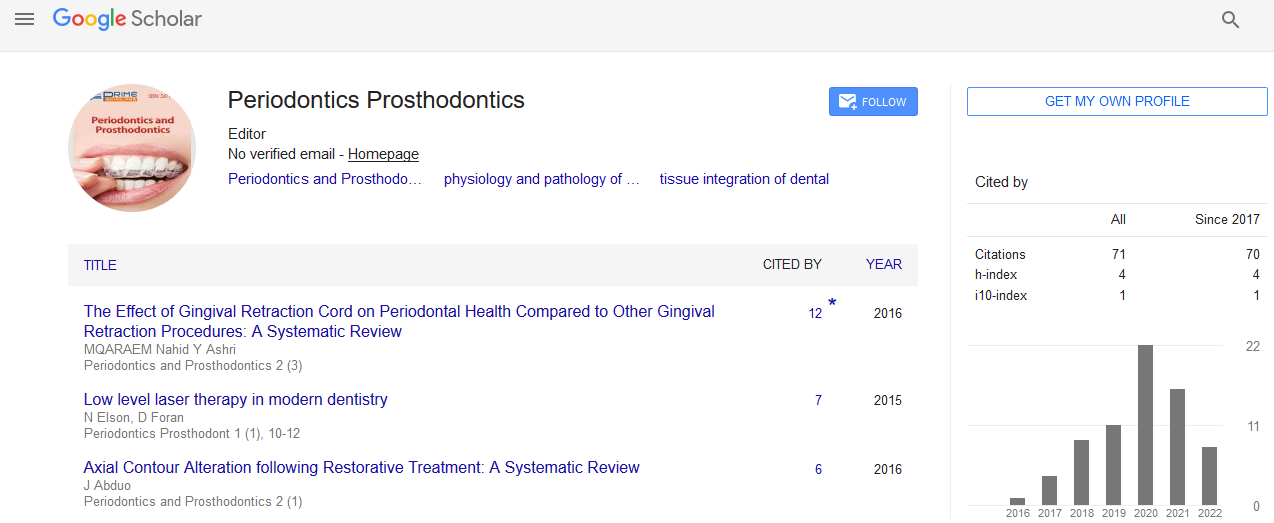Short Communication - (2024) Volume 10, Issue 3
Advancements in Laser-Assisted Periodontal Therapy
Haruki Kei*
Department of Periodontology, Peking University School of Stomatology, China
*Correspondence:
Haruki Kei, Department of Periodontology, Peking University School of Stomatology,
China,
Email:
Received: 02-Sep-2024, Manuscript No. IPPDPD-25-21149 ;
Editor assigned: 04-Sep-2024, Pre QC No. IPPDPD-25-21149 (PQ);
Reviewed: 18-Sep-2024, QC No. IPPDPD-25-21149 ;
Revised: 23-Sep-2024, Manuscript No. IPPDPD-25-21149 (R);
Published:
30-Sep-2024, DOI: 10.36648/2471-3082.24.10.21
INTRODUCTION
The integration of laser technology into periodontal therapy represents a significant advancement in the field of periodontics. Laser-assisted periodontal therapy (LAPT) has emerged as a minimally invasive alternative to traditional periodontal surgery, offering a variety of benefits, including reduced pain, decreased bleeding, and faster healing times. The precision and efficacy of laser technology have allowed for more targeted treatment of periodontal pockets, removal of diseased tissue, and reduction of bacterial load. This short communication aims to provide an overview of the latest advancements in laser-assisted periodontal therapy and discuss its impact on patient outcomes [1,2].
DESCRIPTION
Laser technology has been incorporated into several aspects of periodontal treatment, including scaling and root planning, gingivectomy, and the management of peri-implantitis. Different types of lasers, such as diode, Nd (neodymium-doped yttrium aluminium garnet), and CO2 lasers, are utilized based on the specific clinical scenario. Each type of laser has unique properties that make it suitable for various periodontal applications. For instance, the laser is known for its ability to selectively target pigmented tissues, making it effective for debridement of periodontal pockets and bacterial reduction. One of the most significant advancements in LAPT is the introduction of the LANAP (Laser-Assisted New Attachment Procedure) protocol. This FDA-cleared therapy utilizes the Nd laser to remove infected tissue and promote the regeneration of healthy periodontal tissues. Studies have shown that LANAP® can achieve comparable or superior outcomes to traditional periodontal surgery, with less discomfort and quicker recovery times [3,4]. The ability of lasers to stimulate the formation of new connective tissue attachment and bone regeneration has positioned LAPT as a promising alternative to conventional approaches. In addition to its application in periodontal pocket reduction, laser therapy has shown promise in the treatment of peri-implantitis a condition characterized by inflammation and bone loss around dental implants. Lasers can effectively decontaminate implant surfaces and reduce microbial populations without causing damage to the surrounding tissues. The precision of laser therapy allows for the selective removal of diseased tissue while preserving healthy structures, which is critical in maintaining implant integrity and function. Furthermore, the antimicrobial properties of laser therapy contribute to its effectiveness in managing periodontal infections. Lasers can penetrate deep into periodontal pockets and destroy bacteria, including those resistant to antibiotics. This bactericidal effect, combined with the ability to reduce inflammation and promote tissue healing, makes LAPT a valuable tool in the periodontal arsenal. As laser technology continues to evolve, new wavelengths and delivery systems are being developed to enhance the efficacy and safety of periodontal treatments. Laser is known for its ability to selectively target pigmented tissues, making it effective for debridement of periodontal pockets and bacterial reduction. Recent innovations have also led to the development of dual-wavelength lasers, which combine the benefits of different wavelengths to optimize the treatment of complex periodontal conditions and enhance clinical outcomes.
CONCLUSION
Laser-assisted periodontal therapy represents a significant advancement in the treatment of periodontal disease and peri-implantitis. Its minimally invasive nature, coupled with its ability to promote tissue regeneration and reduce bacterial load, offers a compelling alternative to traditional surgical approaches. As research continues to validate the efficacy of LAPT, it is likely to become an increasingly integral part of periodontal practice. The ongoing development of laser technology and treatment protocols will further enhance the role of lasers in improving patient outcomes and advancing the field of periodontics.
Acknowledgement
None.
Conflict Of Interest
The author’s declared that they have no conflict of interest.
REFERENCES
- Kokten G, Balcioglu H, Beyukertan M (2003) Supernumerary fourth and fifth molars: A case report of two cases. J Contemp Dent Pract 4(4): 1-5. [Crossref] [Google Scholar]
- Pejuan VM, Aytes LB, Escoda CG (2000) Supernumerary molars-a review of 53 cases. Bull Group Int ech Sci Stomatol Odontol 42: 101-105. [Crossref] [Google Scholar]
- Qaradaghi IF (2009) Supernumerary tooth: Report of a rare case of a fourth mandibular molar. Arch Oral Biol 5(2): 157-160. [Crossref] [Google Scholar]
- Singh G (2012) Supernumerary teeth (hyperdontia)-a report of three cases. JIDA 6(1): 45-47. [Crossref] [Google Scholar]
Citation: Kei H (2024) Advancements in Laser-Assisted Periodontal Therapy. Periodon Prosthodon. 10:21.
Copyright: © 2024 Kei H. This is an open-access article distributed under the terms of the Creative Commons Attribution License, which permits unrestricted use, distribution, and reproduction in any medium, provided the original author and source are credited.

